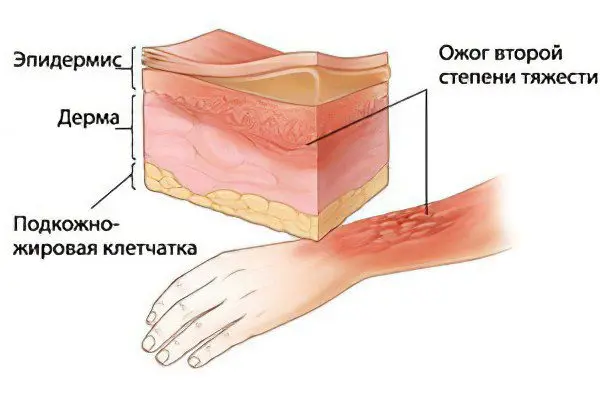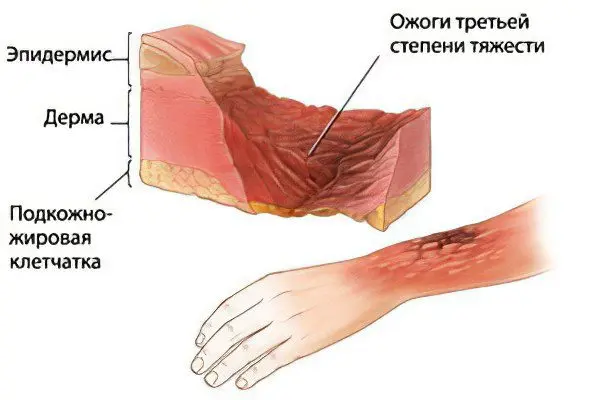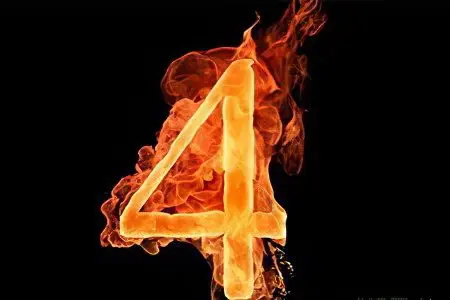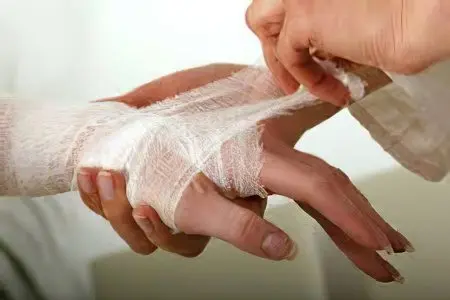Contents
What is a burn?
A burn is damage to the tissue of the human body due to external influences. Several factors can be attributed to external influences. For example, a thermal burn is a burn that occurs as a result of exposure to hot liquids or steam, very hot objects.
Electric burn – with such a burn, internal organs are also affected by an electromagnetic field.
Chemical burns are those that occur due to the action of, for example, iodine, certain acid solutions – in general, various corrosive liquids.
If the burn is due to ultraviolet or infrared radiation, then this is a radiation burn.
There is a percentage of the degree of damage to the whole body. For the head, this is nine percent of the entire body. For each arm – also nine percent, chest – eighteen percent, each leg – eighteen percent and back – also eighteen percent.
Such a division by the percentage of damaged tissues to healthy ones allows you to quickly assess the patient’s condition and correctly draw a conclusion whether it is possible to save a person.
Degrees of burns

The classification of burns by degree is of great importance. Such a division is necessary in order to standardize the amount of therapeutic measures for varying degrees of burns. The classification is based on the possibility of reverse development of changes in a natural way without the use of surgical interventions.
The main zone that determines the regenerative abilities of the affected skin is the preserved germinal part and the microvasculature. If they are affected, early active surgical measures are indicated in the burn wound, since its independent healing is impossible or takes a long time with the formation of a rough scar and a cosmetic defect.
According to the depth of tissue damage, burns are divided into four degrees.
1st degree burn characterized by redness and slight swelling of the skin. Usually recovery in these cases occurs on the fourth or fifth day.
2st degree burn – the appearance of blisters on reddened skin, which may not form immediately. Burn blisters are filled with a clear yellowish liquid; when they burst, a bright red, painful surface of the germ layer of the skin is exposed. Healing, if an infection has joined the wound, occurs within ten to fifteen days without scarring.
3st degree burn – necrosis of the skin with the formation of a gray or black scab.
4st degree burn – necrosis and even charring of not only the skin, but also deeper lying tissues – muscles, tendons and even bones. Dead tissue partially melts and is torn off within a few weeks. Healing is very slow. In place of deep burns, rough scars often form, which, when burned on the face, neck and joints, lead to disfigurement. On the neck and in the area of the joints, as a rule, cicatricial contractures are formed.
This classification is unified throughout the world and is used for almost all types of burns, regardless of the cause of their occurrence (thermal, chemical, radiation). Its convenience and practicality are so obvious that even a person who is not familiar with medicine can easily figure it out.
The basis for the development of pathological changes and clinical manifestations of various degrees of burns is the direct destruction of skin elements by high temperatures. The second component is circulatory disorders in neighboring areas, which play a major role in aggravating the extent and area of damage over time.
A characteristic feature of burn injuries is the increase in these indicators in comparison with the initial ones. It is possible to estimate the true volumes of the burn only on the next day after it was received. By this time, there is a clear restriction of living and dead tissues, although the zone of microcirculatory disturbances remains. For her, and is the main treatment struggle.
1st degree burn

Pathologically, it is represented by damage to the most functionally insignificant upper layer of the skin – the epidermal layer. This zone is subject to permanent replacement under normal conditions. In a healthy person, millions of epidermal cells are exfoliated during the day. Usually the causes of such a burn can be the sun’s rays, hot liquids, weak acids and alkalis. Therefore, such a burn is not accompanied by pronounced structural changes in the affected skin. Microcirculatory disorders are also minimal, which underlies the formation of clinical manifestations.
Signs of a first degree burn skin are reduced to redness (hyperemia) of the affected areas, accompanied by moderate pain. Touching them causes an increase in burning sensation. Edema is moderately expressed or absent at all, depending on the area of the burn. No other manifestations are observed.
First-degree burns are often limited. Widespread isolated superficial lesions are rare and usually associated with deeper lesions. There is no danger of developing a burn disease in case of damage to the epidermis, which is reflected in the minimum amount of therapeutic measures.
Healing of the affected surface with burns of the 1st degree occurs within a few days. The course of the process is characterized by gradual drying and wrinkling of the damaged epidermal layer. Then there is its rejection in the form of peeling. Full recovery takes a little over one week. Rough scars and cosmetic defects, even in the face area, do not remain.
2st degree burn

Such burns are characterized by damage to the deeper layers of the skin and moderately pronounced microcirculation disorders in the affected area and adjacent areas. This type of damage occurs most often and is characterized by a relatively favorable course even with large burn areas.
The epidermis and superficial zones of the dermis, up to the papillary layer, are destroyed. Its significance lies in the fact that the bulk of the capillaries and nerve endings pass here, which forms the clinical manifestations of a burn of the 2nd degree. These structures remain intact. Only their function is temporarily impaired with intact pain sensitivity.
The clinical description of such a burn is the formation of blisters of various sizes and areas filled with a clear straw-yellow liquid. Surrounding skin may be reddened or unchanged. Their formation is possible due to the fact that the dead epidermis forms a cavity that is filled with plasma (the liquid part of the blood) through dilated, partially altered microvessels. Victims are worried about burning pains, which persist for several hours after receiving a burn. Any touch increases the pain. The tissues in the affected area and adjacent areas are edematous.
Second degree burns heal on their own, leaving behind reddened areas that eventually acquire a natural shade and do not stand out among healthy ones. The process of complete restoration of damaged tissues takes, on average, about two weeks. Small burns do not cause any danger in terms of burn disease.
But if their surface is large enough, there is a risk of infection and dehydration, which requires appropriate measures of specialized medical care. It is limited to infusion therapy and antibiotic prophylaxis. All active surgical interventions on the burn surface are reduced to piercing or cutting blisters with fluid evacuation under aseptic conditions.
Sometimes controversial issues arise when determining the degree of a burn and conducting a differential diagnosis between burns of 2 and 3 degrees. After all, both those and others are manifested by bubbles. But here the key role belongs to the preservation of pain sensitivity when touching the burned surface. If present, it is a second degree burn.
3st degree burn

Describing this type of burn, it should be noted that it is divided into two subspecies. The need for this arose due to the fact that the deep layers of the dermis have certain features that are also significant in determining treatment tactics. In general, a 3rd degree burn characterizes a complete lesion of the entire thickness of the skin, up to the subcutaneous tissue.
Consequently, its complete independent recovery becomes impossible. Microcirculatory disorders in the adjacent areas are so pronounced that they can often turn into 2nd degree burns over time.
In terms of the risk of developing a burn disease, this degree of damage is in a very important place. This is due to the fact that burns of this type are often extensive, spreading over a large area. Large volumes of dead tissue and wound surfaces formed in their place. These features lead to the fact that all decay products are actively absorbed into the blood, causing severe intoxication.
Accordingly, the the risk of infection remains high such burns with the development of a septic condition. Recovery of the skin can take several months and in most cases requires surgical intervention. Such damage leaves behind rough scars, which can cause cosmetic defects.
Clinical manifestations determine the division of a 3rd degree burn into two subspecies:
3a degree – damage to the dermis, including the papillary layer. Only the deepest parts of it remain intact, in which the appendages of the skin (hair follicles and sebaceous glands) are laid. This fact determines the possibility of self-healing of small-sized burns due to granulation and marginal epithelization from surrounding healthy areas;
3b degree – damage to all elements of the skin, including adnexal formations. This makes it impossible to restore it independently, since the underlying subcutaneous fatty tissue does not have this ability.
Burns of 1 and 2, as well as 3a degrees, are classified as superficial, due to the ability to self-heal. Determining the degree of a burn is not so difficult if you know what you need to pay attention to.
Criteria characterizing a 3rd degree burn can be distinguished as follows:
With burns 3a, various-sized blisters are formed, filled with a bloody liquid against the background of reddened surrounding tissues;
Wound defects with abundant serous-hemorrhagic (mucous-bloody) secretions, touching which does not cause pain;
3b degree burns are characterized by the formation of thick-walled bloody blisters or dense scabs from dead skin;
Severe swelling and hyperemia of the surrounding skin;
General manifestations in the form of intoxication and dehydration (tachycardia, rapid breathing, drop in blood pressure, fever).
Very important for such burns. hospitalize the injured in a specialized hospital, where early surgical treatment and appropriate medical correction will be carried out, which will prevent the development of a burn disease. It is very difficult to get patients out of the latter state. Therefore, with a given degree of burns, modern combustiologists recommend early surgical treatment with one-stage or staged plastics of burn wounds.
4st degree burn

This type of burn is the most severe, regardless of the area affected. If it spreads within one segment, it can cause death of the patient or loss of a limb. As world practice shows, burns of the 4th degree of a local nature are mainly obtained by a flame or a hot object, being in a state of alcoholic or drug intoxication. Such burns are possible with chemical compounds of an acidic or alkaline nature. Electrical injury of the extremities often takes the form of burns of the hand and forearm of the 4th degree, manifested by complete charring of the fingers.
Morphologically, this type of damage is deep. All layers of the skin and underlying tissues can be destroyed: the subcutaneous fatty base, muscles, ligaments and tendons, bone formations, blood vessels and nerves. Perhaps the circular spread of these changes around the affected limb, which leads to the formation of a dense crust of necrotic tissues and causes compression of the preserved elements and disruption of adequate blood supply.
In terms of clinical manifestations, these burns cannot be confused with anything. In place of the destroyed tissues, a dense thick-walled scab of black or brown color is determined. The general condition of patients is disturbed up to shock and cerebral coma. If the burn area is large, then there is very little time to save a life. Circular damage is especially dangerous. A dense scab that forms a frame, with a progressive increase in tissue edema, becomes a barrier to their stretching, which leads to their compression and loss of chances for salvation. The most relevant is chest compression, which leads to a violation of vital functions and rapid death of the victims in case of failure to provide specialized assistance.
In terms of the development of burn disease, with burns of the 4th degree, its manifestations can be traced from the first hours after they are received. If such burns are limited to small areas, the prognosis for a complete cure is favorable. This process may take several months. For extensive burns, if the victim survives, recovery takes months or even years, since it requires numerous plastic surgeries to replace the formed defects.
The most important thing to remember is that you should not first of all look for an answer to the question about the degree of the burn. It is necessary to quickly and efficiently organize the provision of emergency measures and transportation of the patient to a medical facility, which often determine not only the extent of the lesion, but also the life of a person. Everything else must be entrusted to specialists in this matter who know the intricacies of a complex problem.
How to help the victim?
In domestic conditions. The first step is to cool the skin. To do this, it is enough to lower the burned area of the body in cool water for 10-15 minutes. During this time, the pain will go away, and the redness will decrease. Just don’t use ice! All you need is cold water. After that, it is necessary to treat the skin with a special tool.
The following tools are also used:
Panthenol (or any product that contains panthenol). The drug has an anti-inflammatory effect, improves tissue regeneration, is quickly absorbed (absorbed) by the skin.
Bepanten ointment
Dermosin ointment
Solcoseryl gel
Sulfargin

These funds can significantly reduce the burning force, accelerate the regeneration of the skin and quickly heal the burn itself. If these funds are not available at home, then the burned area of uXNUMXbuXNUMXbthe body can be smeared with raw egg white, aloe juice. Or you can make a poultice out of raw potatoes or pumpkins. You should not use such a popular method as oil and fatty creams. This method really relieves the initial pain, but it only gets worse later.
Home remedies are recommended to be used as a temporary measure, and treatment should be carried out with special ointments, which are listed above.










gariin tohoinos deese mor hvrtlee yndand tvltsen Yuma 5honoj bn geriin nohtsold yaj emchleh be tsewerleed tos tvrheed deerdsen yum baidaggvi